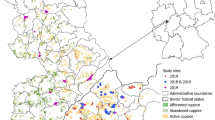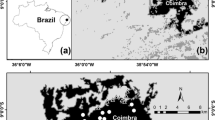Abstract
Edge effects are increasing in forest-dominated landscapes worldwide, due to increased fragmentation by other land uses. Understanding how species respond to edges is therefore critical to define adequate conservation measures. We compared the relative importance of interior and edge habitats for butterflies in a landscape composed of even-aged pine plantations interspersed with semi-natural habitats. Butterfly assemblages were surveyed simultaneously at the edge and the interior of 68 patches belonging to four main habitat types: herbaceous firebreaks, clearcuts and young pine stands, older pine stands, and deciduous woodlands. Butterfly species richness was higher at edges than in interior habitats, especially for pine stands. Assemblage composition differed significantly between edge and interior habitats, except for firebreaks. Of the 23 most abundant butterfly species, seven were significantly more abundant in one or all edge habitat types, five in interior habitats, and 11 species showed no edge-interior preference. Modelling the presence of individual species in edge habitats revealed the importance of habitat variables such as the abundance of nectar and host-plants, but also of the abundance of the same species in the adjacent interior habitat. Moreover, our results suggest that most species use several, different habitat types to find supplementary or complementary resources, including micro-climatic refuges to escape hot temperatures during summer. The use of adjacent edge and interior habitats by butterflies is probably a key process in such mosaic landscapes and underlines the importance of landscape heterogeneity for butterfly conservation.



Similar content being viewed by others
References
Asher J, Warren M, Fox R, Harding P, Jeffcoate G, Jeffcoate S (2001) The millennium atlas of butterflies in Britain and Ireland. Oxford University Press, Oxford
Barbaro L, van Halder I (2009) Linking bird, carabid beetle and butterfly life-history traits to habitat fragmentation in mosaic landscapes. Ecography 32:321–333
Barbaro L, Pontcharraud L, Vetillard F, Guyon D, Jactel H (2005) Comparative responses of bird, carabid, and spider assemblages to stand and landscape diversity in maritime pine plantation forests. Ecoscience 12:110–121
Bergman KO (1999) Habitat utilization by Lopinga achine (Nymphalidae : Satyrinae) larvae and ovipositing females: implications for conservation. Biol Conserv 88:69–74
Bink FA (1992) Ecologische atlas van de dagvlinders van Noordwest-Europa. Schuyt & Co, Haarlem
Brockerhoff EG, Jactel H, Parrotta JA, Quine CP, Sayer J (2008) Plantation forests and biodiversity: oxymoron or opportunity? Biodiv Conserv 17:925–951
Clarke KR (1993) Nonparametric multivariate analyses of changes in community structure. Aust J Ecol 18:117–143
Clausen HD, Holbeck HB, Reddersen J (2001) Factors influencing abundance of butterflies and burnet moths in the uncultivated habitats of an organic farm in Denmark. Biol Conserv 98:167–178
Dennis RLH (2004) Butterfly habitats, broad-scale biotope affiliations, and structural exploitation of vegetation at finer scales: the matrix revisited. Ecol Entomol 29:744–752
Dennis RLH, Sparks TH (2006) When is a habitat not a habitat? Dramatic resource use changes under differing weather conditions for the butterfly Plebejus argus. Biol Conserv 129:291–301
Dennis RLH, Shreeve TG, Van Dyck H (2003) Towards a functional resource-based concept for habitat: a butterfly biology viewpoint. Oikos 102:417–426
Dover JW (1996) Factors affecting the distribution of satyrid butterflies on arable farmland. J Appl Ecol 33:723–734
Dover J, Sparks T (2000) A review of the ecology of butterflies in British hedgerows. J Environ Manage 60:51–63
Downie IS, Coulson JC, Butterfield JEL (1996) Distribution and dynamics of surface-dwelling spiders across a pasture-plantation ecotone. Ecography 19:29–40
Duelli P, Studer M, Marchand I, Jakob S (1990) Population movements of arthropods between natural and cultivated areas. Biol Conserv 54:193–207
Duelli P, Obrist MK, Fluckiger PF (2002) Forest edges are biodiversity hotspots - also for Neuroptera. Acta Zool Hung 48:75–87
Dunning JB, Danielson BJ, Pulliam HR (1992) Ecological processes that affect populations in complex landscapes. Oikos 65:169–175
Ebert G, Rennwald E (1991) Die Schmetterlinge Baden-Württembergs. Band 1 & 2 Tagfalter. Verlag Eugen Ulmer, Stuttgart
Ewers RM, Didham RK (2006) Confounding factors in the detection of species responses to habitat fragmentation. Biol Rev 81:117–142
Feber RE, Smith H, Macdonald DW (1996) The effects on butterfly abundance of the management of uncropped edges of arable fields. J Appl Ecol 33:1191–1205
Feber RE, Brereton TM, Warren MS, Oates M (2001) The impacts of deer on woodland butterflies: the good, the bad and the complex. Forestry 74:271–276
Ferris R, Carter C (2000) Managing rides, roadsides and edge habitats in lowland forests. Forestry Commission Bulletin 123
Fletcher RJ (2005) Multiple edge effects and their implications in fragmented landscapes. J Anim Ecol 74:342–352
Greatorex-Davies JN, Sparks TH, Hall ML, Marrs RH (1993) The influence of shade on butterflies in rides of coniferised lowland woods in southern England and implications for conservation management. Biol Conserv 63:31–41
Haddad NM (1999) Corridor use predicted from behaviors at habitat boundaries. Am Nat 153:215–227
Hardy PB, Sparks TH, Isaac NJB, Dennis RLH (2007) Specialism for larval and adult consumer resources among British butterflies: implications for conservation. Biol Conserv 138:440–452
Haynes KJ, Cronin JT (2006) Interpatch movement and edge effects: the role of behavioral responses to the landscape matrix. Oikos 113:43–54
Imbeau L, Drapeau P, Mokkonen M (2003) Are forest birds categorised as “edge species” strictly associated with edges? Ecography 26:514–520
Karsholt O, Razowski J (1996) The Lepidoptera of Europe. A distributional checklist. Apollo Books, Stenstrup
Krauss J, Steffan-Dewenter I, Tscharntke T (2003) How does landscape context contribute to effects of habitat fragmentation on diversity and population density of butterflies? J Biogeogr 30:889–900
Kuussaari M, Heliola J, Luoto M, Poyry J (2007) Determinants of local species richness of diurnal Lepidoptera in boreal agricultural landscapes. Agr Ecosyst Environ 122:366–376
Lafranchis T (2000) Les papillons de jour en France. Belgique et Luxembourg et leurs chenilles, Biotope, Mèze (France)
Lehtinen RM, Ramanamanjato JB, Raveloarison JG (2003) Edge effects and extinction proneness in a herpetofauna from Madagascar. Biodivers Conserv 12:1357–1370
Lin YC, James R, Dolman PM (2007) Conservation of heathland ground beetles (Coleoptera, Carabidae): the value of lowland coniferous plantations. Biodivers Conserv 16:1337–1358
McArdle BH, Anderson MJ (2001) Fitting multivariate models to community data: a comment on distance-based redundancy analysis. Ecology 82:290–297
McGarigal K, Cushman SA, Neel MC, Ene E (2002) FRAGSTATS: Spatial pattern analysis program for categorical maps. Computer software program produced by the authors at the University of Massachusetts, Amherst. Available at www.umass.edu/landeco/research/fragstats/fragstats.html
Niemela J, Koivula M, Kotze DJ (2007) The effects of forestry on carabid beetles (Coleoptera: Carabidae) in boreal forests. J Insect Conserv 11:5–18
Ockinger E, Smith HG (2007) Semi-natural grasslands as population sources for pollinating insects in agricultural landscapes. J Appl Ecol 44:50–59
Ohwaki A, Nakamura K, Tanabe SI (2007) Butterfly assemblages in a traditional agricultural landscape: importance of secondary forests for conserving diversity, life history specialists and endemics. Biodiv Conserv 16:1521–1539
Ouin A, Aviron S, Dover J, Burel F (2004) Complementation/supplementation of resources for butterflies in agricultural landscapes. Agr Ecosyst Environ 103:473–479
Paquet JY, Vandevyvre X, Delahaye L, Rondeux J (2006) Bird assemblages in a mixed woodland-farmland landscape: the conservation value of silviculture-dependant open areas in plantation forest. For Ecol Manag 227:59–70
Pollard E, Yates TJ (1993) Monitoring butterflies for ecology and conservation. Chapman & Hall, London
Ries L, Debinski DM (2001) Butterfly responses to habitat edges in the highly fragmented prairies of Central Iowa. J Anim Ecol 70:840–852
Ries L, Sisk TD (2004) A predictive model of edge effects. Ecology 85:2917–2926
Ries L, Sisk TD (2008) Butterfly edge effects are predicted by a simple model in a complex landscape. Oecologia 156:75–86
Ries L, Fletcher RJ, Battin J, Sisk TD (2004) Ecological responses to habitat edges: mechanisms, models, and variability explained. Ann Rev Ecol Evol Syst 35:491–522
Robertson PA, Clarke SA, Warren MS (1995) Woodland management and butterfly diversity. In: Pullin AS (ed) Ecology and conservation of butterflies. Chapman & Hall, London, pp 113–122
Schtickzelle N, Baguette M (2003) Behavioural responses to habitat patch boundaries restrict dispersal and generate emigration-patch area relationships in fragmented landscapes. J Anim Ecol 72:533–545
Shreeve TG (1984) Habitat selection, mate location, and microclimatic constraints on the activity of the speckled wood butterfly (Pararge aegeria). Oikos 42:371–377
Spector S, Ayzama S (2003) Rapid turnover and edge effects in dung beetle assemblages (Scarabaeidae) at a Bolivian Neotropical forest-savanna ecotone. Biotropica 35:394–404
Stevens SM, Husband TP (1998) The influence of edge on small mammals: evidence from Brazilian Atlantic forest fragments. Biol Conserv 85:1–8
Sutcliffe OL, Thomas CD (1996) Open corridors appear to facilitate dispersal by ringlet butterflies (Aphantopus hyperantus) between woodland clearings. Conserv Biol 10:1359–1365
Tudor O, Dennis RLH, Greatorex-Davies JN, Sparks TH (2004) Flower preferences of woodland butterflies in the UK: nectaring specialists are species of conservation concern. Biol Conserv 119:397–403
van Halder I, Barbaro L, Corcket E, Jactel H (2008) Importance of semi-natural habitats for the conservation of butterfly communities in landscapes dominated by pine plantations. Biodiv Conserv 17:1149–1169
van Swaay CAM, Warren MS (1999) Red data book of European butterflies (Rhopalocera). Council of Europe Publishing, Strasbourg
Vanreusel W, Maes D, Van Dyck H (2007) Transferability of species distribution models: a functional habitat approach for two regionally threatened butterflies. Conserv Biol 21:201–212
Wahlberg N (2001) On the status of the scarce fritillary Euphydryas maturna (Lepidoptera : Nymphalidae) in Finland. Entomologica Fennica 12:244–250
Weibull AC, Bengtsson J, Nohlgren E (2000) Diversity of butterflies in the agricultural landscape: the role of farming system and landscape heterogeneity. Ecography 23:743–750
Wiklund C (1977) Oviposition, feeding and spatial separation of breeding and foraging habitats in a population of Leptidea sinapis (Lepidoptera). Oikos 28:56–68
Zimmerman GM, Goetz H, Mielke PWJ (1985) Use of an improved statistical method for group comparisons to study effects of prairie fire. Ecology 66:606–611
Acknowledgments
We wish to thank Audrey Lugot for her help during the field work and Stephen Pawson for his useful remarks and his corrections of the english text. This study was financed by the European Union, ERDF-Interreg Atlantic Area, FORSEE project.
Author information
Authors and Affiliations
Corresponding author
Electronic supplementary material
Below is the link to the electronic supplementary material.
Online Resource 1
(PDF 19 kb)
Online Resource 2
(PDF 27 kb)
Rights and permissions
About this article
Cite this article
van Halder, I., Barbaro, L. & Jactel, H. Conserving butterflies in fragmented plantation forests: are edge and interior habitats equally important?. J Insect Conserv 15, 591–601 (2011). https://doi.org/10.1007/s10841-010-9360-9
Received:
Accepted:
Published:
Issue Date:
DOI: https://doi.org/10.1007/s10841-010-9360-9




